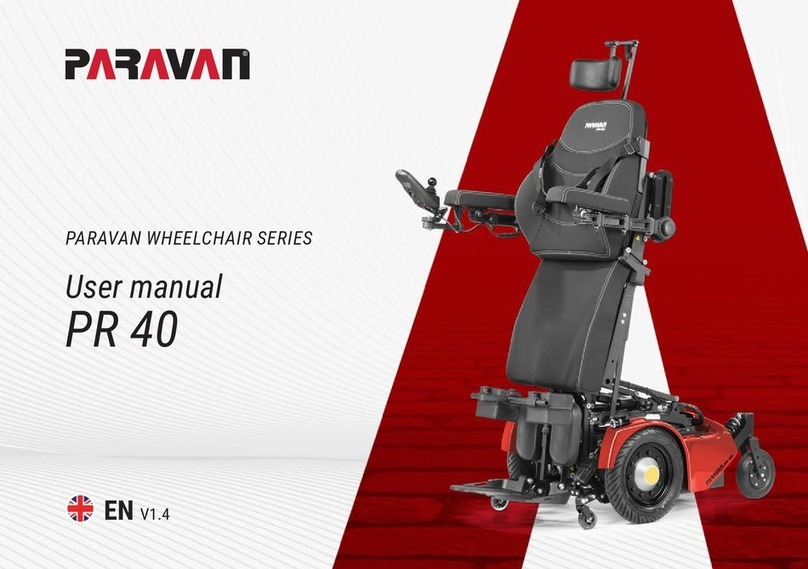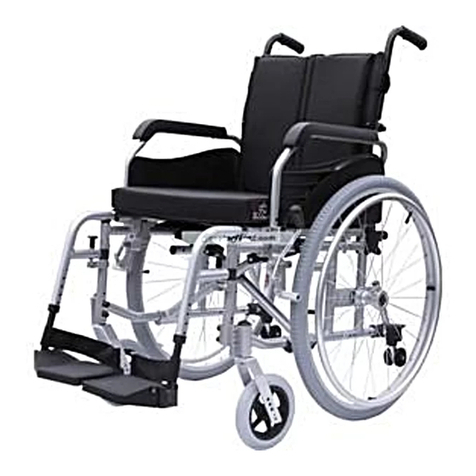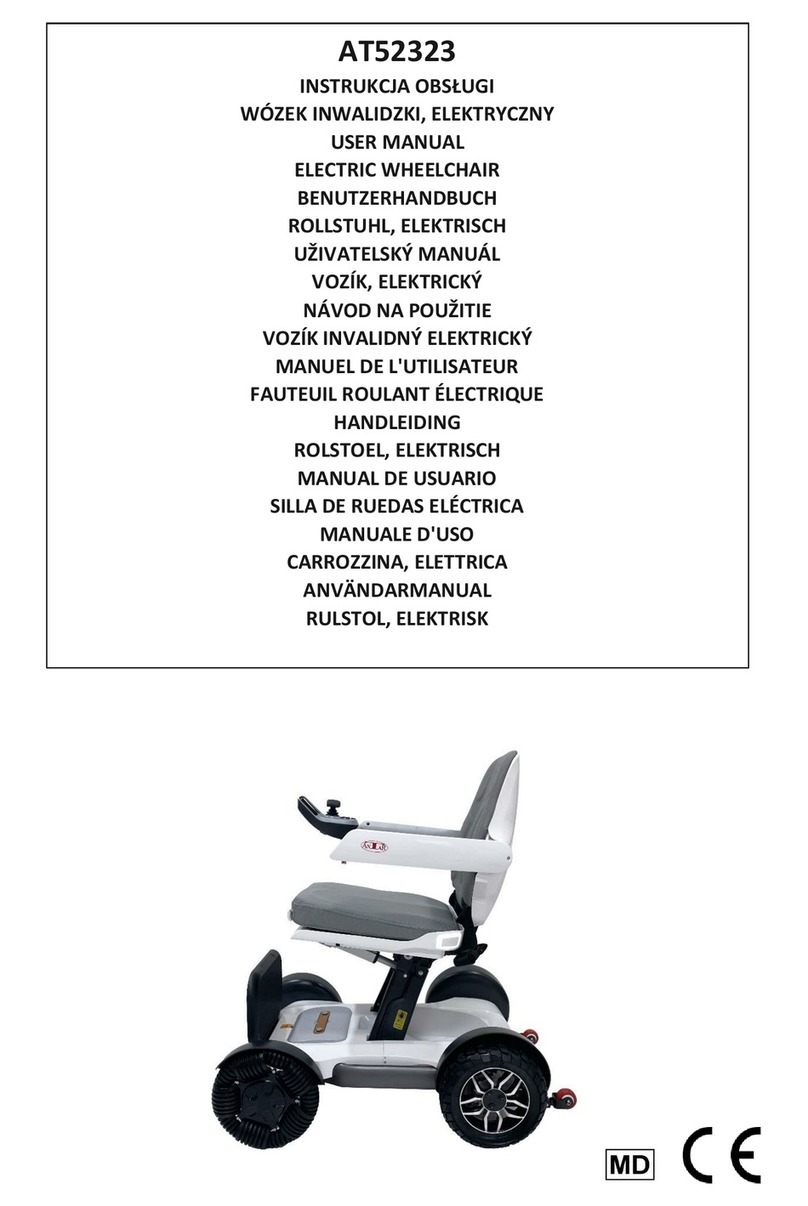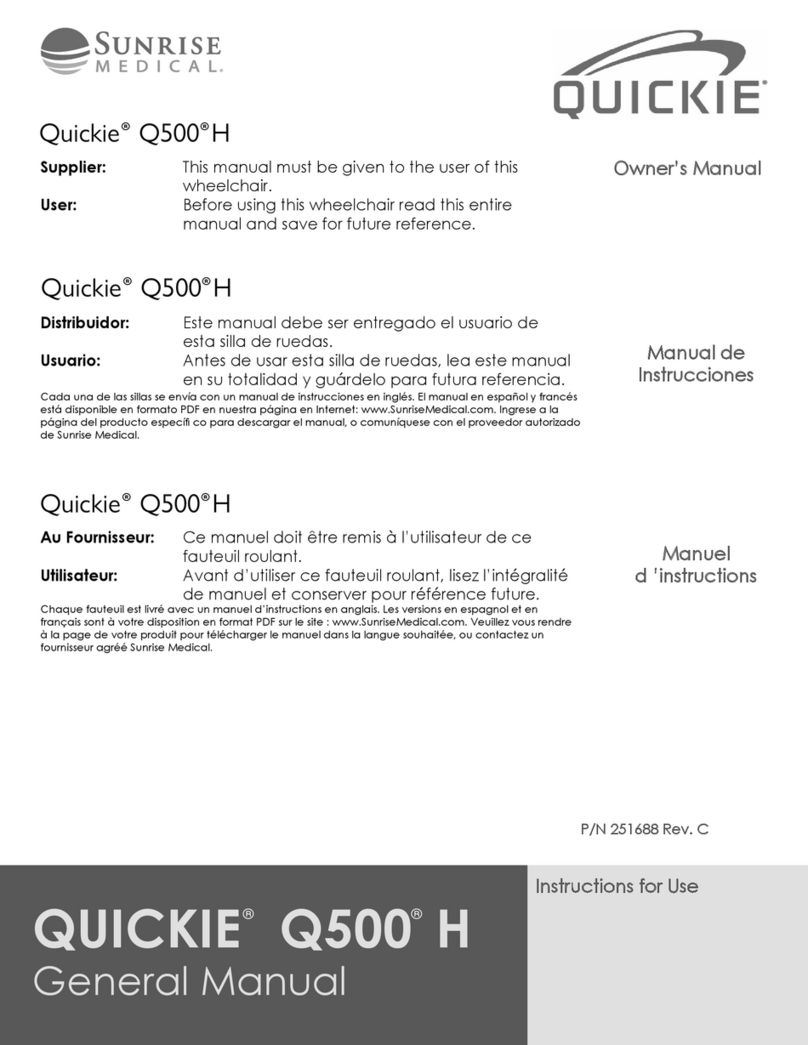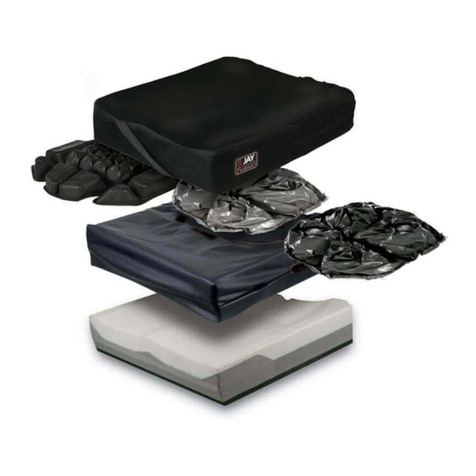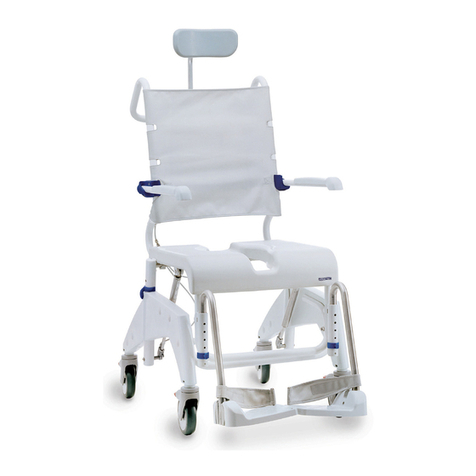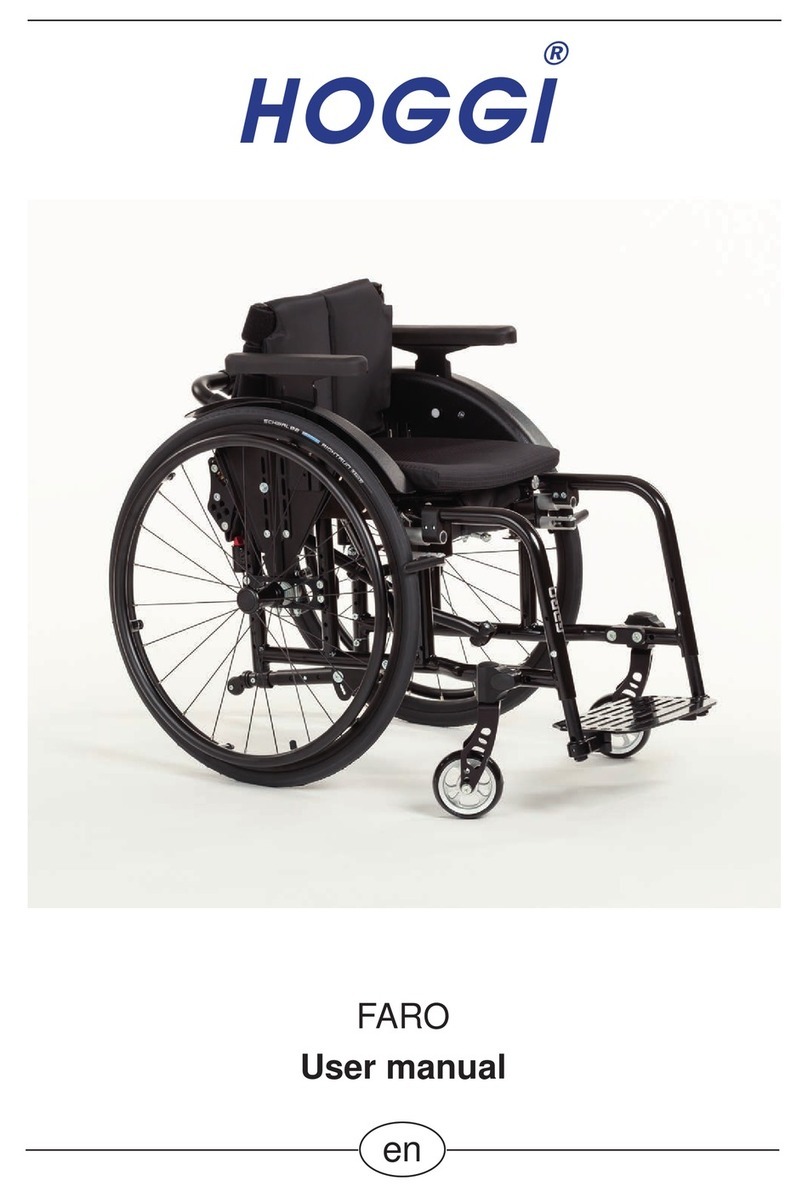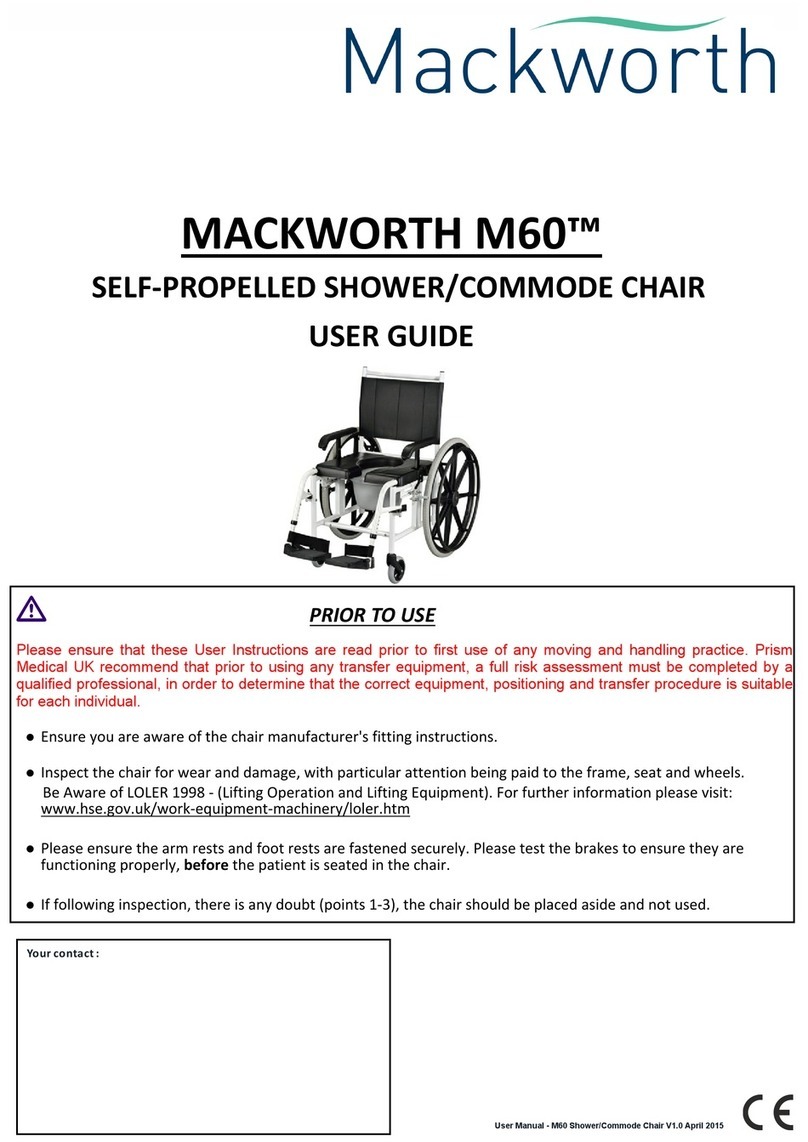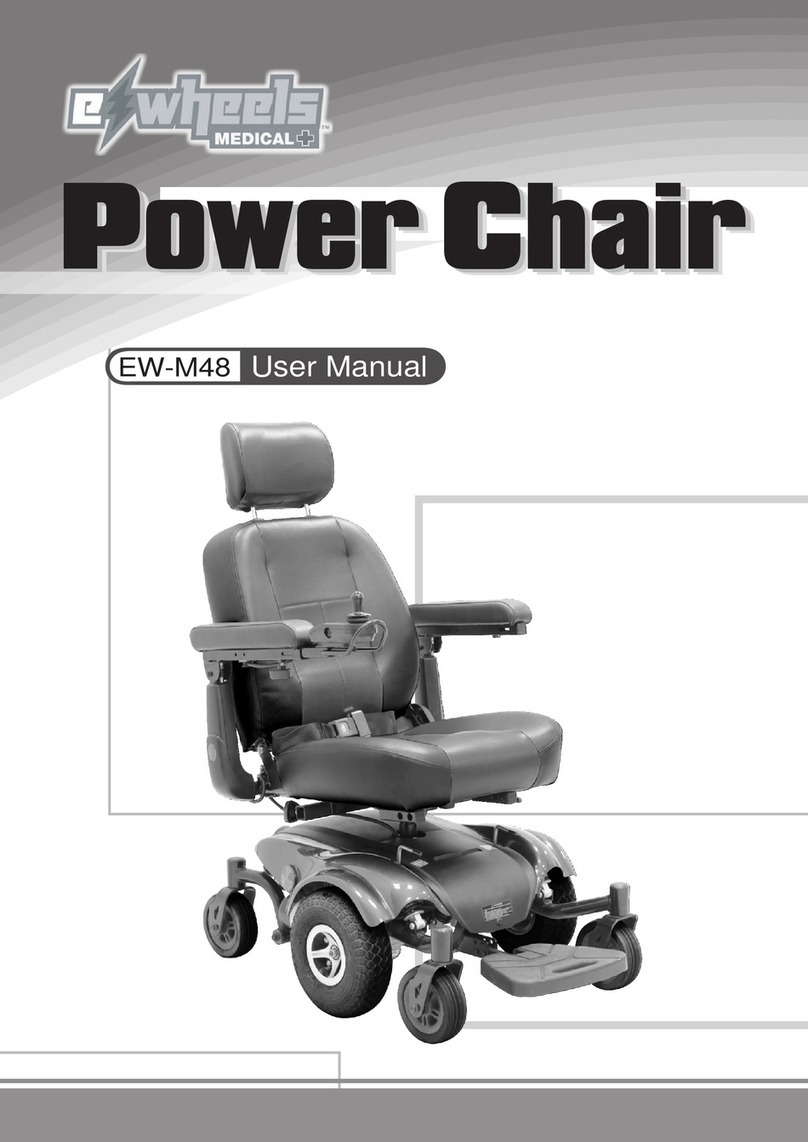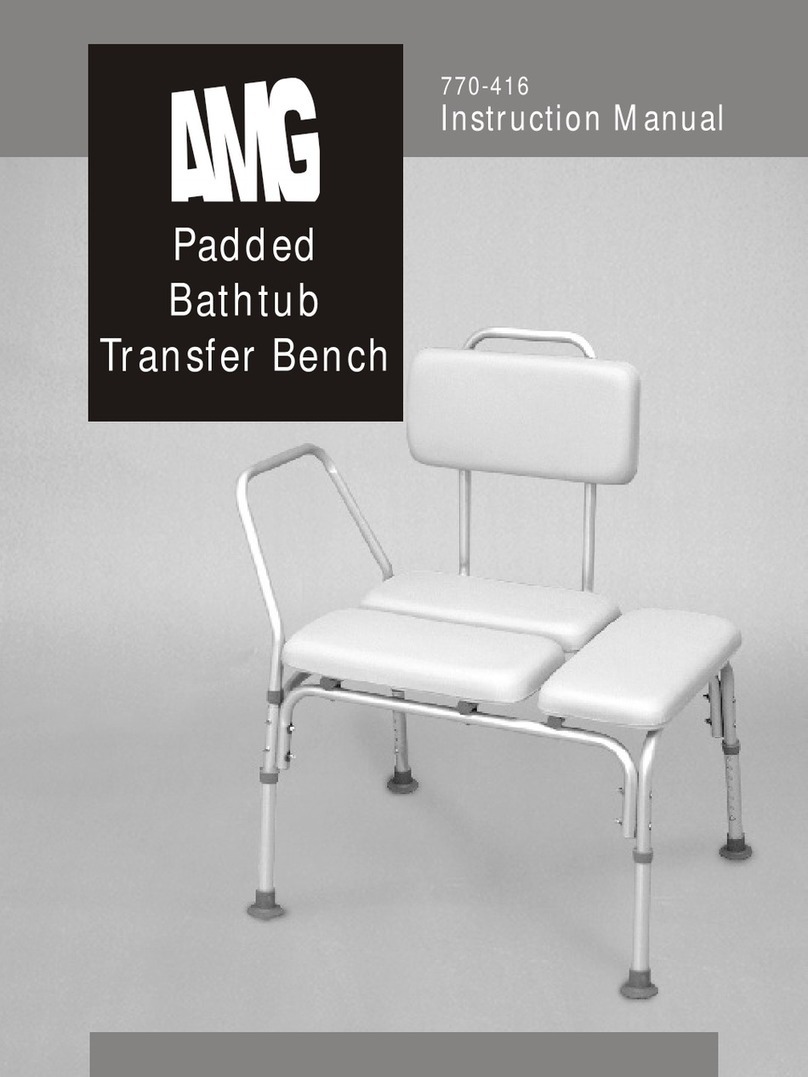Roma Medical Reno II P319 User manual

Reno II
Model – P319
USER MANUAL
Please ensure that this manual is read and understood before using
the powerchair.
Oct 2014
Rev 1
KB&S17249

Contents Page
Introduction 3
Intended Use 3
Technical Specification 3
Feature Guide 4
Safety Advice 5
Adjustments & Battery Removal
Joystickdepth 6
Footplate height 6
Seatswivel 7
Armwidth 7
Flip up armrest & angle adjustment 8
Battery removal 8
VR2 Joystick Controller 9
Brake Release / Freewheel Operation 10
Starting to Drive
Getting Started 11
MovingOff 11
Steering 11
Reversing 11
Dropkerbs 11
Reaching and stretching 12
Disassembly & Assembly 13
Battery and Battery Charger 16
Maintenance 17
Troubleshooting
Circuit Breaker 17
CheckList 18
VR2errorcodes 18
Further Information 19 →
Warranty
2

Introduction
Congratulations on your purchase of the ROMA Reno powerchair. This powerchair
incorporates the latest innovative designs. The ROMA Reno can be used in confined
spaces both indoors and out. The powerchair can be easily dismantled without tools
and will fit into the boot of vehicles for easy transport or stored neatly indoors. The
detachable battery pack allows convenient charging wherever necessary.
Intended Use
The ROMA Reno was carefully designed for indoor or outdoor use in paved pedestrian
areas by a single individual with limited mobility up to a maximum weight of 136kg
(21st).
Your assessor/healthcare professional will determine the suitability of the powerchair for
each individuals intended use.
Note: Persons with lower body amputations should not use this device unless evaluated
with artificial limbs fitted, as stability may be compromised due to an irregular centre of
gravity.
Technical Specification
Class 1 Medical Device (93/42/EEC as amended by 2007/47/EC)
Class 2 Indoor/Outdoor Vehicle (Use of Invalid Carriages on Highways Act)
Overall Size Seat Dimensions
Length 870mm Width 460mm
Width 570mm Depth 380mm
Height 860mm Seat to footrest 430 - 520mm
Battery 22Ah Backrest height 410mm / 16”
Height (Seat
Removed) 420mm Range (Up To) 20km (12.5m)*
Maximum user
weight 136kg / 21st Seat to floor 530mm
Safe working
slope 6º Battery charger (off
board) 4 amp
Weight with
battery 59.5kg Turning radius 700mm
Max. Speed 6km/h (4mph) Battery pack weight 14kg
*Passenger weight, rough ground conditions, low temperatures and battery condition
can affect maximum range.
Component Weights:-
Battery Pack – 14kg Seat – 11.5kg
Rear Chassis – 20kg Front Chassis – 14kg
3

Feature Guide
‘Reno’
1
2
4
8
3
5
7
6
1. Programmable joystick controller
2. Flip up, width adjustable armrests
3. Padded seat and fold down backrest
4. Removable battery pack
5. Rear anti-tippers
6. Puncture proof non-marking wheels
7. Flip up and depth adjustable footplate
8. Handy storage basket
4

Safety Advice
DO:
Read this manual carefully before using your powerchair
Turn the power off when transferring to and from the powerchair
Select a slow speed when going down gradients (max 6°) or over uneven ground
Keep your feet on the powerchair whilst driving
Ensure the seat is locked in the ‘forward’ position
Avoid rough or soft terrain and long grass wherever possible
Be aware of other road users when crossing roads
Turn the power off when not in use
Follow the maintenance guide to ensure safe operation of the powerchair
DO NOT:
Carry passengers
Exceed inclines over 6°
Traverse inclines
Attempt inclines if the surface is slippery
Turn sharply at full speed
Exit or enter the powerchair unless the power is switched off
Switch off the power whilst driving – this will cause the powerchair to stop abruptly
Use the powerchair where you cannot safely or legally walk
Attempt to climb kerbs except drop down kerbs
Use the powerchair if under the influence of alcohol or any medication
Use a mobile phone whilst driving
Attempt to negotiate steps or escalators
Attempt to tow any other devices
Exceed the stated weight limit
Connect any unauthorised devices to the battery as this could cause permanent
damage and void your warranty
Use any other battery/charger other than those supplied by ROMA
Travel through water or over soft terrain (mud, sand etc.) Avoid cobbles if possible
Travel on the road except when crossing between pavements
Lift the powerchair by the seat assembly or any plastic part
Sharply shift your centre of gravity as this could make the powerchair unstable
Every care has been taken to ensure that your powerchair will give you safe, reliable
service provided you adhere to the advice given above.
5

Adjustments and Battery Removal
Joystick Depth Adjustment
It is possible to adjust the depth of the joystick controller for added comfort. Simply
loosen the handknob and slide the joystick to the required distance and fully re-tighten
the handknob.
Footplate Height Adjustment
The height of the footplate can be adjusted by fully undoing the two fixing bolts. When
removed, place the footplate at the desired height and re-insert the bolts and tighten
fully. Both screws must be used when re-fitting.
6

Continued…..
Seat swivel & Removal
The seat can be swivelled around the base unit. Lift up on the lever on the right side of
the seat and rotate as necessary.
To remove the seat fold down the backrest, lift up the lever and gently pull the seat
upwards away from the chair at the same time.
The seat is required to be swivelled to remove the battery pack.
The joystick MUST be unplugged before removing the seat to prevent damage to the
cable.
Armwidth adjustment
The armrest width can be quickly adjusted without tools. Under the rear of the seat there
are two handknobs. Loosen the handknob and adjust the armrests as desired and re-
tighten the handknobs.
7

Continued…..
Flip up armrests & angle adjustment
The armrests flip up to allow for easier transfers.
Simply lift the armrest when transferring.
The angle of the armrest can be adjusted by undoing the locking nut and setting at the
desired height. The nut should then be tightened to lock the adjustment in place.
Battery removal
The battery can be easily removed for charging away from the powerchair or for
storage.
The seat must be swivelled to the left or right by 90 degrees (or removed) the battery
can then be removed by holding the handle, depressing the release trigger and lifting
the pack out towards the rear of the chair.
Always ensure the power is switched off at the joystick before removing the battery
pack.
Release Trigger
8

Continued…..
VR2 Joystick Controller
3
1
4
2
Battery Gauge (1)
This is a 10-segment display, which indicates if
the VR2 is switched on and gives the state of
charge of the battery. Also, any faults in your
power chair’s electrical system are also
indicated by this display. Refer to page 16 for
details.
7
5
6
Maximum Speed Indicator (2)
This is a 5-segment display, which indicates
the speed setting selected. 1 bar indicates
the slowest setting and 5 bars the fastest.
VR2 Joystick
On/Off Button (3)
This button turns your joystick controller on and off. Do not use this button to stop the
power chair, except in an emergency.
Horn Button (4)
This button operates your powerchair’s horn. This should only be used to warn others of
your presence and not as a rebuke of any form.
Speed Decrease Button (5)
This button decreases your maximum speed.
Speed Increase Button (6)
This button increases your maximum speed.
Joystick (7)
This controls the speed and direction of your powerchair. Push the joystick in the
direction you want to go. The further you push it, the faster the speed will be. Releasing
the joystick will automatically engage the brakes and bring the powerchair to a
controlled stop.
‘Sleep’ Mode
If the joystick is left on and the powerchair is not used for 10 minutes, it will go into ‘sleep’
mode. Simply turn the power on to resume operation.
9

Continued…..
Joystick ‘Lock’ Function
Your VR2 controller is equipped with a lock function to prevent any unauthorised use. To
lock the controller:
When the power is on, press and hold the power button for about 1 second until
the system bleeps.
Move the joystick forward until it bleeps, then move it to the back position until
you hear a bleep.
Release the joystick – you should now hear a long bleep, this indicates the system
is now locked.
To unlock the controller:
Press the power button until the speed indicator lights go from left to right.
Move the joystick forward until it bleeps, then move it to the back position until
you hear a bleep.
Release the joystick – you should hear another bleep, this indicates that the
system is unlocked and ready for use.
Should the rubber boot/gaitor or keypad on the joystick become damaged, replace
immediately to prevent damage to the internal components.
Brake Release / Freewheel Operation
To release the electromagnetic brakes go to the back of the powerchair and rotate the
two levers away from the chair as indicated by the labelling. The powerchair may now
be pushed. This function is not intended to be used for moving the powerchair when
occupied unless in an emergency. Rotate both levers as indicated by the labelling to
re-engage the brakes.
Shows freewheel position
Caution! Never leave the powerchair unattended whilst in freewheel mode as it will roll
away down an incline. ‘Freewheel’ mode should only be used in an emergency to
move the powerchair due to power failure. NEVER move the powerchair in this mode
whilst it is occupied. DO NOT use your feet to operate the electromagnetic brakes as this
will apply excessive force and damage the mechanisms. This could lead to the
powerchair being inoperable.
10

Starting to drive your powerchair
Getting Started
Select an area with plenty of space.
Ensure that when seated in the in the powerchair you are in a comfortable position and
can easily and freely operate the controls.
Moving off and steering
Turn the power on and check that your battery is fully charged.
Set your speed to a low setting.
Gently push the joystick in the direction you wish to travel. The harder you push the
joystick the faster you will travel.
Release the joystick, this will automatically return to the centre position and the
electromagnetic brakes will be activated.
Reversing
Before reversing please ensure that the area behind is free from any hazard or
obstruction. DO NOT reverse down an incline without supervision.
Drop Kerb Climbing
We recommend that a suitable access point such as a drop kerb or ramp be used at all
times.
When driving up the drop kerb, always address the edge as shown in the illustration
below. This will ensure maximum stability.
Edge of drop kerb
Warning: Do not hit the drop kerb at speed and do not attempt to climb a drop kerb if
the anti tipping castors have been removed. Please take time to get accustomed to
your new powerchair before driving in heavily pedestrianised areas.
11

Continued…..
Drop Kerb Descent
Do not reverse down drop kerbs, please use a ramp/drop-kerb in forward motion to
descend.
Warning: NEVER reverse down a drop kerb or ramp onto a main thoroughfare.
Reaching and Stretching
Care must be taken when reaching and stretching for objects as this may affect the
stability of the powerchair.
When attempting to reach for objects it is very important that the power is OFF.
Do not attempt to reach for objects on the floor by leaning forward or
reaching between your knees.
Do not attempt to reach for high objects by moving to the front of the
seat. NEVER stand on the footplate to reach for objects.
Do not attempt to reach for objects behind you by leaning over the
back of the seat.
12

Disassembly & Assembly
Warning: We advise caution when disassembling and lifting items. You must ensure that
the person undertaking the action is able to safely and correctly handle the weight to
avoid any personal injury.
Ensure that the power is switched off and the joystick cable is disconnected before
dismantling.
The motors MUST be in the Drive / Engaged position to disassemble and assemble the
powerchair.
Remove the seat as described earlier.
Remove the battery pack as described earlier.
Locate the yellow release lever as shown below and pull backwards – this will cause the
frame to separate.
The front chassis can then be lifted away from the rear as shown below for
transportation.
13

Continued…..
To reassemble locate the pivot pin of the front chassis into the receiving slots of the rear
chassis (each side) and lowered to the bottom location.
Fully located in the bottom position
14

Continued…..
Push down on the rear part of the frame as shown below. This will reconnect the two
parts of the frame together. You will hear the latch ‘click’ into place.
ALWAYS check that both parts are fully connected before refitting the seat and battery
box.
Refit the battery box and seat and reconnect the joystick. The scooter is now ready for
use.
15

Battery and Battery Charger
IMPORTANT: The VR2 controller MUST be switched off when charging.
Battery Charger
The battery charger is a 4 amp switch mode type off board. The battery charging port is
located on the underside of the joystick controller. There is also a charging port on the
battery pack. This special feature allows the battery to be charged independently of
the main powerchair.
Before using your powerchair for the first time be sure to fully charge the battery pack,
this may take up to 8 hours.
To charge the battery connect the 3-pin male charger plug into the charging socket on
the joystick / battery pack (to use the charge socket on the battery pack it must be
removed). Plug the 3-pin mains plug into a wall socket and switch on.
There will be a constant red light on the charger which indicates power is on. When
charging the light changes to yellow, a green LED light indicates charging is complete.
Caution! Do not charge the battery for longer than 12 hours. Always charge the battery
in a well-ventilated indoor area. You must still maintain charging the battery even if the
powerchair is not to be used for a prolonged period of time (2 to 3 weeks). Failure to do
so could result in permanent damage and render the battery unusable. Wherever
possible do not interrupt the charge cycle until the battery is fully charged. Continual
interruption can permanently damage the battery. If the charging lead should get
damaged discontinue use immediately and seek a replacement from your dealer.
ONLY USE THE CHARGER SUPPLIED WITH YOUR POWERCHAIR. Do not leave the charger
plugged into to the charger port after the charge is complete.
Disposing and recycling of used battery
Batteries must always be recycled correctly. Do not dispose of them with your domestic
refuge.
For further information regarding your nearest recycling facility please contact your
local authority.
Battery Pack
The Reno has a 22Ah AGM (2 x 12v) battery pack which has the advantage of being
removable for charging off board.
Do not open the battery pack. Always seek the advice of your mobility retailer should
fuses or batteries need replacing. Failure to do so could result in damage to the battery
pack.
If the powerchair is to be unused for extended periods fully charge the battery pack and
remove it completely from the powerchair. The battery pack should not be stored for
prolonged periods in cold environments (do not leave it outside in a garage / shed over
the winter period if not used) as this can cause permanent damage to the batteries.
16

Maintenance
Product Life Expectancy
Your powerchair has been designed to provide the user with a long, reliable life
provided it is correctly maintained and regularly serviced by an authorised dealer.
However, due to inevitable wear and tear and technological improvements it is
recommended that the average useable life of this powerchair is five years.
Cleaning
The frame and seat of the powerchair should be cleaned using a damp cloth and
gentle detergent. Do not use abrasive cleaners or solvents, as this will damage the
plastic components. Do not spray water (hose or pressure washer) onto the powerchair
as this may cause damage to the electronics.
Routine Maintenance
We suggest that your powerchair should undergo a full service at least once a year by
an authorised ROMA dealer.
Please check the following on a weekly basis:
Tyres are in good condition
Wheels spin freely (castors)
Moving parts, pivots and frame fixings are not damaged or worn
All hand knobs and levers are secure
Note: Should any part of your powerchair need replacing or repairing please contact
your local ROMA dealer to undertake any maintenance. Failure to do this may void your
Warranty.
Troubleshooting
Circuit Breaker
Your powerchair is fitted with the latest in electronic controls that are programmed to
protect the electrical system from abnormal overloads. Fitted for extra protection is a
circuit breaker, which is located under the carry handle of the battery pack. Should
there be a situation where your powerchair stops for no apparent reason please check
that the circuit breaker has not tripped. Simply press the button to reset the circuit
breaker.
Note: Should the circuit breaker continue
to trip, turn off the powerchair
immediately and consult your dealer.
17

Continued…..
Check List
If your powerchair fails to operate, please check the following:
The unit is switched on.
All plugs and connections are firmly fixed.
Battery level shows full charge.
Freewheeling device is in the drive position.
Circuit breaker has not tripped.
Battery and controller lead are properly connected.
If the freewheel device has been operated with the powerchair switched on, the
powerchair will not operate until the unit has been turned off and on again.
VR2 Error Codes
Your VR2 controller has the ability to diagnose possible errors in the electrical system,
which may prevent your powerchair from operating. These are displayed on the battery
gauge. The fault is shown against the number of lights flashing on the display.
Battery Gauge Possible Fault
10 bars flash Battery voltage too high. Check battery connections.
9 bars flash Electromagnetic brake fault – check freewheel.
8 bars flash Possible controller fault – check connection / cable.
7 bars flash Possible joystick fault – check connection / cable.
6 bars flash Battery charger connected.
5 bars flash Right hand motor wiring fault – check connection.
4 bars flash Right hand motor disconnected – check connection.
3 bars flash Left hand motor wiring fault – check connection.
2 bars flash Left hand motor disconnected – check connection.
1 bar flashing Low battery voltage – charge batteries.
Note: If your powerchair fails to operate after checking the above possible faults consult
your local Dealer immediately. Also ensure that the VR2 has not been accidentally
locked – refer to page 10.
18

Further Information
Safety Information Regarding Electromagnetic Interference (EMI)
Powerchairs and powerchairs are designed to operate under certain conditions.
However, radio waves or electromagnetic fields may affect the operation of the
powerchair. The source of EMI could be radio or television transmitters or portable
devices such as mobile phones, portable CB radios etc.
Should any unintentional movement occur turn the powerchair off as soon as safely
possible.
Solar Energy
During periods of sunny weather, it is possible that surfaces of your powerchair may
reach high temperatures (as with motor vehicles). Please take precautions if leaving the
powerchair in direct sunlight for any period of time. Seek shade or cover the seat and
joystick to keep any temperature increases to a minimum.
Health Factors
Suitability for this product has been assessed on the user’s current state of health. It is
essential that the user regularly monitor their ability to use the powerchair safely.
General Use
Take heed of the information given in this manual regarding safety and the
maintenance of your powerchair. If adhered to, your powerchair should give you years
of reliable mobility.
Storage and General Care
We recommend that the powerchair is always stored in a dry environment such as in
the home or garage to protect the chassis and other components from corrosion. Do
not leave the powerchair outside during rainstorms. If the powerchair is wet, wipe with a
dry cloth to ensure there is no ingress of water into the internal components of the
powerchair.
During everyday use, do not use in rain showers or travel through puddles. Avoid use in
areas where the powerchair could become contaminated with sand or abrasive
materials.
19

Continued…..
Product Stability
Powerchairs are designed to allow the user flexibility of movement in restricted areas.
Driving at maximum speed and attempting sharp turns can create a situation where the
product becomes unstable. Therefore it is essential that the user pay attention the
guidance set out in this manual.
The main factors affecting stability are:
Maximum speed setting
Seat height
User movement
User’s manoeuvres
Gradients or slopes
Please keep your speed to a level where you can safely stop without having to make
any erratic turns.
Do not load bags etc. on the back of the seat as this will affect the centre of gravity
and could increase instability.
Do not lean outside of the ‘footprint’ of the product, especially whilst moving.
Avoid making turns on gradients or slopes.
Adjustment of your lap belt
Ensure that you are sitting back fully into the seat with the pelvis as upright as possible
and not leaning to one side.
Close the buckle and position the belt so that the hip bones can be felt above the lap
belt.
Adjust the strap length by pulling on the open end of the belt. As a guide, the belt
should be adjusted so that there is sufficient room for two fingers to slide between your
body and the belt.
Warning: Should any damage occur to the lap belt, please replace immediately. The
user should transfer to a bespoke vehicle seat whilst being transported. DO NOT sit in the
powerchair whilst in any moving vehicle.
Driving in Pedestrian Areas
As mentioned previously, when using the powerchair in pedestrian areas always lower
your maximum speed to that of the pedestrians around you. Remember the stopping
distance of your powerchair and always allow enough space to stop safely to avoid
collisions with pedestrians or other objects.
20
Table of contents
Other Roma Medical Wheelchair manuals

Roma Medical
Roma Medical 1823 User manual

Roma Medical
Roma Medical 1300 User manual

Roma Medical
Roma Medical Reno Elite P325 User manual

Roma Medical
Roma Medical sirocco p110 User manual

Roma Medical
Roma Medical 1232 User manual

Roma Medical
Roma Medical Marbella P200 User manual

Roma Medical
Roma Medical Shoprider User manual

Roma Medical
Roma Medical 1415 Self Propel Wheelchair User manual

Roma Medical
Roma Medical 1500 User manual

Roma Medical
Roma Medical P001 User manual


